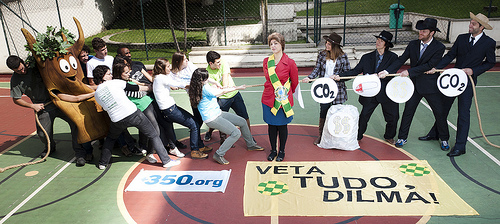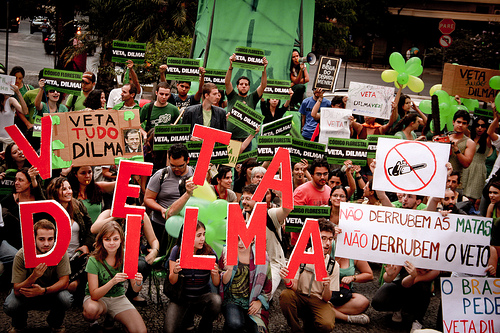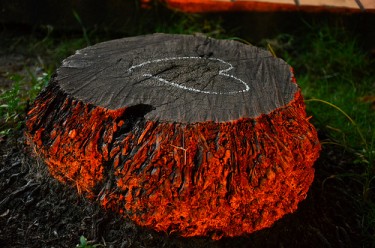This post is part of our special coverage Forest Focus: Amazon
Online social media has been abuzz since the approval of the new Forestry Code in Brazil by the National Congress, on April 25, 2012, with 274 votes in support and 184 against [pt]. President Dilma Rousseff, who can use her presidential legal right in congress to veto the future of forests up until May 25, has been in the spotlight of online conversations over the past few weeks.
The rationale driving the bill is that agribusiness is hindered by the existing Code and Brazil is missing out on opportunities for economic development. However, environmental activists are campaigning for a “zero deforestation” bill for the sake of biodiversity, for the protection of ecological processes and for the slowdown of climate change.
Under the hashtags #VetaDilma, #VetaTudoDilma and #CodigoFlorestal on Twitter, and also out on the streets, worldwide citizens are urging President Dilma to veto the controversial bill.
Main environmental advocay organizations, such as WWF and Green Peace, show their objection to the bill. The most effective advocacy campaign in terms of online outreach has been Avaaz's “Tell Brazilian President Dilma to stop the #Amazon chainsaw massacre and veto the forest code!”, already signed by more than 2 million people:
We call on you to take immediate action to save Brazil's precious forests by vetoing the changes to the forest law. We also urge you to prevent further murders of environmental activists and workers by increasing law enforcement against illegal loggers and ramping up protection for people at risk from violence or death. The world needs Brazil to be an international leader on the environment. Your strong action now will safeguard the planet for future generations.
The petition was delivered directly to President Dilma on May 24, the eve of the “D-Day for the Amazon“, as Lou Gold, from the blog Visionshare calls it:
“D” is for Dilma's Decision, Deforestation, Development and Drought

"President Dilma, connect the dots and veto the new Forest Code!" Photo by Ricardo Lisboa/ 350.org on Flickr (CC BY-NC-SA 2.0)
Many creative campaigns keep emerging online while Dilma's decision is yet to be known, such as this set of cartoons [pt] in Humor Político and the following funk song by MC Cerrado:
Several bloggers have reported in-depth analyses about the new Forestry Code.
The blog Esse Tal de Meio Ambiente has a series of more than 40 posts [pt], in which they expose legal and political implications behind the new bill, aiming to ease rules on forest farmers who have cleared woodlands to make way for crops as well as to give federal states powers over the decision of how much forest needs to be replaced along riversides.
Journalist Julimária Dutra on her blog, Argumentto, wrote [pt] an overview about the Forestry Code, from its origin in 1934 – aiming to regulate the extractive practices – until nowadays when it establishes a new management scheme for forests and protected environmental areas in all six biomes of Brazil, delivering a long-sought after victory to the country's powerful agriculture lobby.
While the blog Brasil! Pra mim states that some “may argue that Brazil’s future economy is also at stake if the veto is given”, Dutra starts her article writing about a very specific illustration of the impact behind the exploitation of forest-based economy. The example she points out is on the international industry of cosmetics, the case of the famous perfume Chanel no. 5, which is made from oil essence of a rare tree:
Árvores como a do pau-rosa que medem cerca de 20 metros e possui uma essência penetrante e sutil fazem parte das 60 toneladas de essências exportadas para outras nações, sendo o pau- rosa, uma espécie em extinção e que por ano são arrancados de modo ilegal mais de seis mil pés. A face oculta para manter o luxo anos a fio reduz o número da fauna e flora amazônica.
Despite which economic interests speak louder, Lou Gold, writing from Acre, summarizes the whole picture:
I guess it depends on whether or not one wants to maintain the forest as a vast storehouse of carbon and hedge against global warming; as home for an incredible number of plant and animal species; and as a biotic pump that draws rain inland for agriculture.
This post is part of our special coverage Forest Focus: Amazon









1 comment